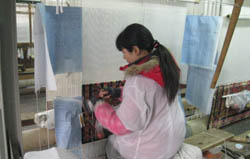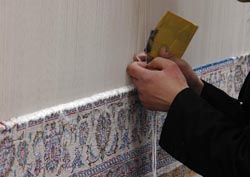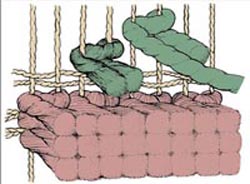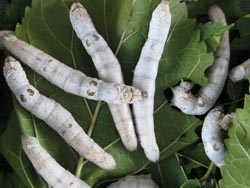 |
Knotting
Silk Rug |
 |
Knot
and Cut the Yarn) |
 |
Turkish
knot(double knot,symmetrical knot) |
 |
Persian
knot(single knot,asymmetrical knot) |
 |
Genuine
Silk Yarn |
 |
Draw
Design |
 |
Design
Chart |
 |
Tools |
 Silk Worm
Silk Worm
 Cocoons
Cocoons |
| |
|
What
is the silk carpet?
The silk carpet means that the piles and warps are made of genuine
natural silk. They are various in designs, luxurious in appearance,
harmonious in colors matching, shining and smooth in surface,
soft yet durable in texture, well proportioned in pattern, anti-worm-eaten
not drop hair. Hand-knot silk carpets are of highly artistic value.
They are practical for use and valuable for collection. To possess
a high quality silk rug is not only a treasure for a lifetime
but also an heirloom for next generation.
How to make the silk carpets? It is very complicated
to make silk rugs.1.Draw design and match colors. Draw design
on a chart and match the different colors on it so that the weavers
can follow to weave. This is a creative work. The artisans must
have a blue print in their mind. Actually the finished carpet
is the representation of the design. To some extent, this is a
very important step because the good designs and harmonious colors
matching directly relate to the value of the silk rug. 2. Dye
silk. Traditionally dyers use natural pigments (indigo, saffron
crocus, acorn cup, and larkspur stem...) to dye the silk into
different colors. But now chemical dye is also used. There are
always 10-20 different colored silk yarns used for one silk rug.
3. Hang the warps. Warps will be bound on the loom rack, which
is almost like a standing frame consisting of 4 bars. The warps
will be bound tightly and evenly between the top bar and the bottom
one. Heddles will be bound between another horizontal bar and
the warps so that they can separate the front warps and the back
warps. After the foundation is woven by plain silk thread the
carpet knotting can start. 4. Hand knot silk carpet. The silk
yarn will be tied around the two adjoining warp yarns to create
a knot. There are different types of knots such as real tied double
knots (symmetrical knots and Turkish knots), real tied single
knots (unsymmetrical knots or Persian knots) and untied hooked
knots (They are unreal knots, which are poor workmanship but time
saving and material saving.). The end of the silk yarn is cut
off by knife to create the pile. When a raw of knots is finished
the wefts are woven through compartment space between front and
back warps. Weavers use iron comb to hit the piles so that they
can fix together firmly. 5. Shear carpet, make tassels, and wash
the finished carpet. After months' or even years' work the whole
silk carpet is finished. It is cut down from the loom rack. The
surface of the silk rug is sheared evenly. The ends of the warps
are bound to make beautiful tassels. The whole rug is washed thoroughly
for sale.
Hand knotting silk rug is a time consuming work and harmful for
eyes. It took one weaver 3 months to knot a 2×3ft silk carpet
with 470 real tied double knots per square inch quality (standard
260 lines double knots workmanship). But it took one experienced
weaver almost one year to knot a 2×3ft silk carpet with 1100 real
tied double knots per square inch quality (standard 400 lines
double knots workmanship). So the high quality silk rugs are called
"soft gold".
Knot density and line
of hand-knotted silk rugs: 260lines: 22 knots per inch
and 470knots per square inch; 300lines:25 knots per inch and 625knots
per square inch; 400lines: 33 knots per inch and 1100 knots per
square inch; 500lines: 41-42 knot per inch and 1730knots per square
inch.
Normal sizes and shapes
for area silk rugs: 1m=3.28ft, 1 square meter=10.76 square
feet.
2x3ft=61x91cm, 3x5ft=91x152cm, 4x6ft=121x183cm, 5.5x8ft=168x244cm,
6x9ft=183x274cm, 6.56x9.84ft=200x300cm, 7x10ft=213x305cm, 8x8ft=244x244cm,
8x10ft=244x305cm, 8.2x11.48ft=250x350cm, 9x12ft=274x365cm, 10x14ft=305x427cm,
12x18ft=366x549cm, 2.5x8ft=76x244cm, 2.5x10ft=76x305cm, 3x12ft=91x365cm
Rectangular, square, runner, oval and round are normal shapes
of silk carpets.
How to choose the silk
rugs? Choose the right size: When choosing an area silk
carpet you should realize the actual size of the silk rug is in
approximate size that you want. Silk carpets are works of art
and are not made to cover the entire floor, so you should leave
1 to 2 feet (30 to 60 centimeters) of vacant space between the
edge of carpet and its surrounding furniture or walls. Choose
the right designs: 1. Allover: Carpets in this layout have no
central design and the designs spread throughout the whole carpet
separately or connected. There may be one same design or several
designs appearing repeatedly throughout the whole carpet. 2. Medallion:
In this layout, a large centerpiece is the main design called
"Medallion". And this layout is the most popular one
in handmade carpets. The shapes of medallions are usually circular,
oval, octagonal, hexagonal and star-like. This kind of carpets
is always symmetric in layout. 3. One-sided: For this layout,
the designs are only properly viewed from one side. The designs
on one-sided carpets are usually images of people, animals and
sceneries. Since one-sided carpets should not be viewed upside-down
they are often used as wall hangings. Choose the right colors:
Silk carpets have many colors but the first impression of the
color a carpet gives you is the contrast of various colors that
creates the different designs. This is the same way in all other
art fields. The colors of a carpet are mainly identified by the
field (background) color and the border color. The field color
is dominant and it usually covers the most space of the whole
rug. The most commonly used background colors are red, blue, black,
beige, white and yellow. Usually the silk rug will appear dark
and light colors if you view from different angles. When choosing
the silk carpet you should consider whether the field color matches
your furniture and the wall.
What
is the number of lines and knots count for hand-made silk carpets?
The knot density and knot workmanship are of the most
important factors to determine the value of the silk rug. The
quality of silk, the harmony of colors, the balance of the pattern
and regular shape are also important factors to determine the
quality of a silk rug. As far as the knot density concerned, higher
density of knots means more work and higher quality. High quality
silk rugs usually have 400 real knots per square inch (KPI) or
above. Above 600 KPI can be regarded as very high quality. Above
900 KPI is regarded as super fine quality. Above 1100KPI rugs
are extremely fine and rare; but most of them are very small because
they are too difficult to make. In china we also use the lines
to mark the quality of hand-made rugs. Suppose standard 240lines
rugs there are 20knots per inch horizontally and vertically. For
standard 260lines rug, there are 22 knots per inch horizontally
and vertically. For standard 300lines rug, there are 25 knots
per inch horizontally and vertically. For standard 400lines rug,
there are 33 knots per inch horizontally and vertically. For standard
500lines rug, there are 41-42 knots per inch horizontally and
vertically. However some dishonest dealers always exaggerate the
actual lines of the rugs.
What is the difference
between the different knotting workmanship of silk carpets? There
are different types of knot workmanship. Real double knots workmanship
(symmetrical knots or Turkish knots) is the best and most difficult
to make. This kind of knot workmanship makes the silk rug very
solid; the piles and the warps are fixed tightly; dense piles
always stand even baring heavy traffic for a long time; the piles
do not drop off. Another real single knot workmanship (unsymmetrical
knot or Persian knot) is also good. For this kind of silk rug
the structure is a little bit soft. The poor workmanship is the
hooked knot workmanship (unreal knot) because the piles are hooked
not tied on two adjacent back warps to create the unreal knots.
This poor workmanship can save the working time and material.
The piles are not dense, which makes the designs obscure. It is
easy to open the piles to see the inside warps. This kind of rug
is not durable and solid. So the value of this kind silk rug is
much less.
What is genuine
silk, spun silk and artificial silk rugs? A lot of so
called silk rugs are not real natural silk made. Real silk rug
means the piles and warps are made of genuine natural silk. High
quality real silk is directly reeled off from the best part of
the cocoons. The fibers are natural, long, soft, durable, smooth
and shining. If you see the piles you can find they are consist
of each single silk filament. When touching, it feels warm. Real
silk pile will not drop hair in use. Spun silk is also called
silk but it is not in high quality because the yarn is spun from
the broken cocoons and silk waste. It has short fibers and it
is like the thin rope. Spun silk is treated and it is not very
shining, smooth and durable. Artificial silk (rayon and mercerized
cotton) is very cheap and in poor quality. The yarn is like the
thin rope and the fiber is short, the color is dull. It feels
cool to touch.
How to test real silk
rugs? Rubbing the surface you could feel real silk is
warm, the artificial silk rug stays cool to the touch. If you
scratch the piles hardly genuine silk pile will not drop hair
but artificial silk will drop hair. Burning the yarn is very effective
and practical test. Clip off a small piece of the fringe and pull
a knot out of the rug from the back and burn the yarn. Look at
the ash and smell the smoke. If the material was rayon and mercerized
cotton, the ash should be soft and chalky, and the smell should
be like burning paper. If it is real silk the ash should be black
and crispy, and the smell should be like burning hair because
real silk contains rich protein like our hair. Chemical test is
accurate. At room temperature, mix a solution of 16 g copper sulfate
(CuSO4) in 150 cc of water, add 8-10 g glycerine, then add caustic
soda (sodium hydroxide: NaOH) until a clear solution is obtained.
This solution will dissolve a small sample of natural silk, but
will leave cotton, rayon, and nylon unchanged.
Phone:(+86)-13501103837
Wechat:13501103837 Fax:(+8610)-65854230 E-mail: chinasilkug@msn.com
Beijing silk rug stroe address:Building 31-1707, Zaoyingbeili,
Chaoyang District, Beijing,China
|